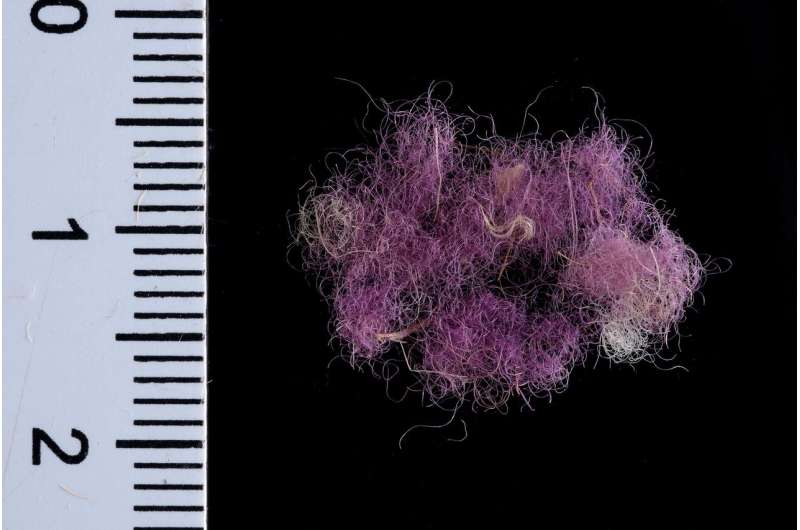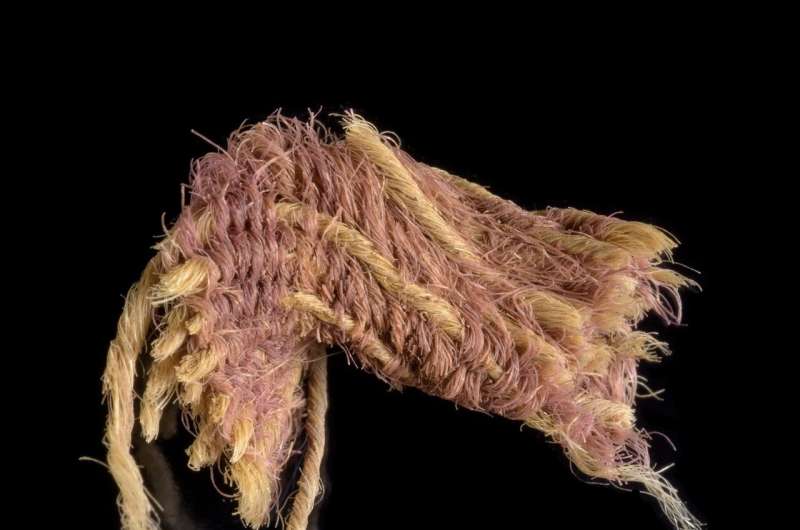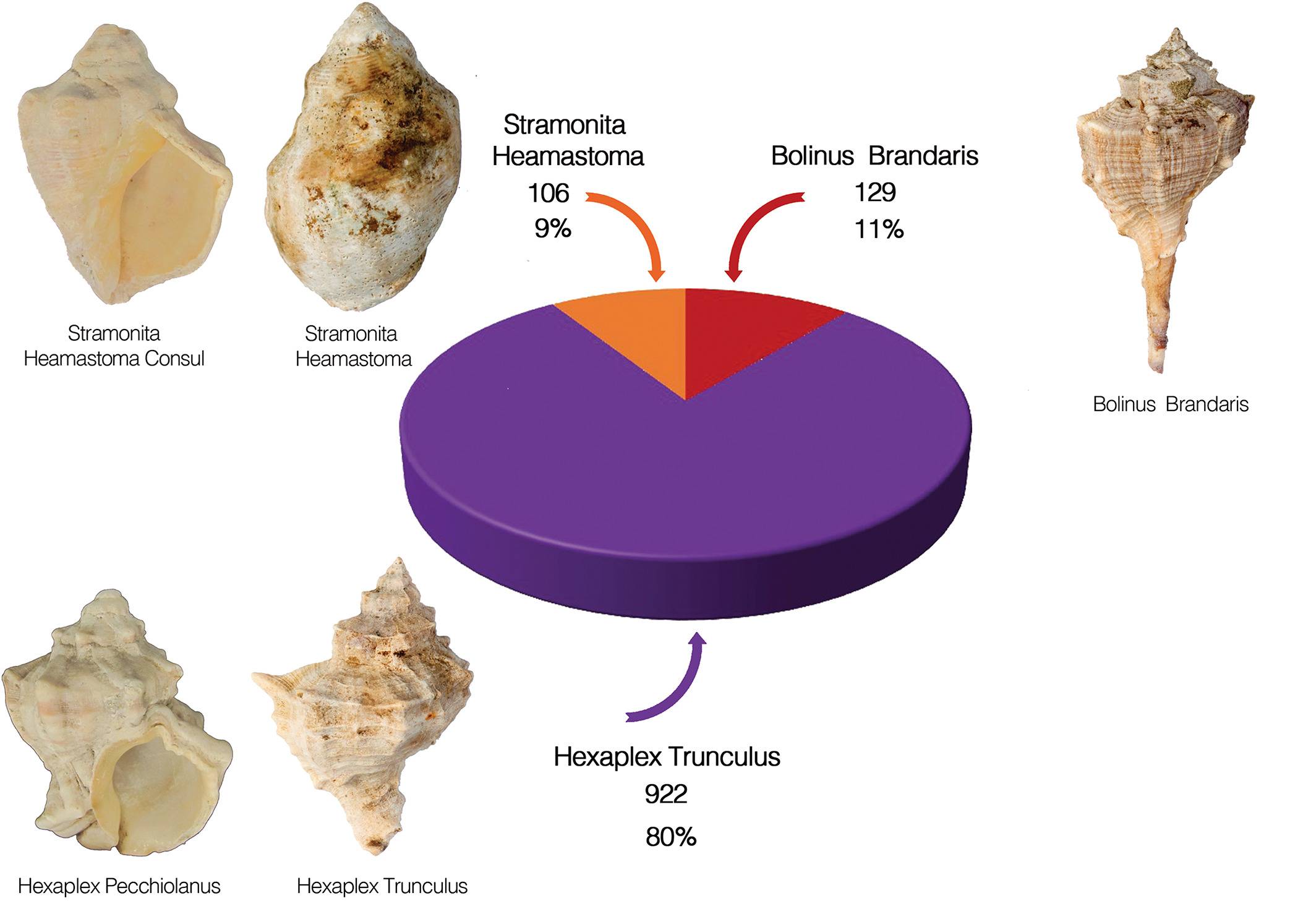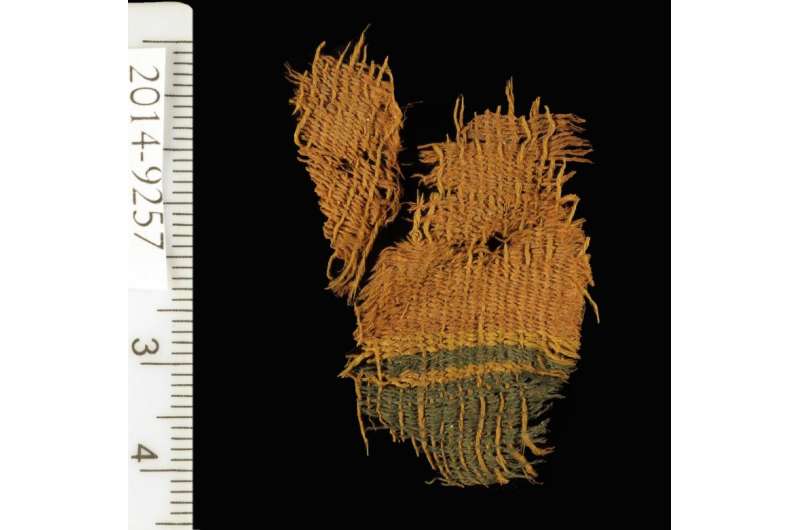
Exploring King David & Solomon's Ancient Wardrobes
After Saul’s unsuccessful attempt at establishing the kingdom, David (Hebrew: Dāwīḏ, David) succeeded him. David defeated the Philistines and other military campaigns, made friendly alliances with neighboring kingdoms, and turned Israel into a strong regional power. As a result, David’s authority extended from the borders of Egypt and the Red Sea to the banks of the Euphrates River. He secured the region from Damascus in the north to the Gulf of Aqaba in the south and established Jerusalem as the capital, laying the foundation for the Kingdom of Israel.
Domestically, David initiated a new governance system. He unified the 12 tribes of Israel into one kingdom, placing Jerusalem and the monarchy as the pillars of the nation. According to biblical tradition, David possessed diverse talents beyond politics, including poetry and music.
The International Context at the Time
Around 1200 BCE, the Catastrophe led to the collapse of the Hittites, while Egypt, Assyria, and Babylon were in decline. This situation created a power vacuum in the historical region of Syria (Levant), leading to the emergence of numerous small states, including Israel, free from major powers’ interference.

A war broke out between Israel and the Philistines, and among the Philistines was the giant Goliath. Goliath was a very large and powerful warrior, and the soldiers of Israel were afraid of him. Goliath challenged the soldiers of Israel, declaring that if anyone could defeat him, the Philistines would become slaves of Israel. However, if no one could defeat Goliath, then the soldiers of Israel would become slaves.
David heard this challenge and decided to fight for Israel. He did not use traditional armor or weapons, but instead used stones and a sling. With his sling, David threw a stone and struck Goliath on the forehead, defeating him. This victory made David a hero in Israel and set him on the path to becoming king.
– Old Testament ‘First Book of Samuel’ Chapter 17
Solomon (Hebrew: Šəlōmōh, Shlomo), David’s son, inherited and greatly strengthened his father’s kingdom. He forged treaties and political marriages with neighboring kingdoms, turning his nation into a strong power. Especially towards Egypt, he maintained a subservient and respectful stance, marrying the Egyptian king’s daughter to build strong relations.
Solomon expanded foreign trade and undertook large projects like copper mining and metal refining to develop the nation’s economy. He established a bureaucratic system for governance and reinforced cities throughout the country. He is famous for building the magnificent Temple in Jerusalem (Solomon’s Temple), which became the center of Jewish national life, religion, and culture. Proverbs and Song of Solomon in the Old Testament were once thought to be his works. However, in his later years, he tolerated faiths other than Judaism, leading to religious conflicts between orthodox Jews and other religious followers, contributing to the eventual division of the kingdom.
Solomon’s long reign brought economic prosperity and international fame, but the unified kingdom began to unravel due to the common people’s discontent. They were burdened with heavy taxes and labor for Solomon’s ambitious projects. Solomon’s preferential treatment of his tribe also angered other tribes, leading to a growing rift between monarchists and tribal separatists.
Around 922 BCE, Solomon’s death and the loss of tribal control led to the division of the united Kingdom of Israel into the Northern Kingdom, known as Israel, and the Southern Kingdom, known as Judah.
The lineages of the divided kingdoms of Israel and Judah After the split, Rehoboam initially gathered soldiers from Judah and Benjamin to quell the rebellion but refrained from marching north after heeding the advice of Shemaiah, a man of God. Chronicles 11 records the fortification of cities in Judah, mainly in the south of Jerusalem, suggesting Rehoboam recognized Israel as a separate power and did not want to provoke them, as inferred by scholars like Gihon and Herzog.
The United Kingdom of Israel’s maximum territory, excluding Phoenician city-states along the Mediterranean, was about 34,000 square kilometers, of which 24,000 square kilometers were inherited by the ten tribes of Israel. The first capital was Shechem, later moving to Tirzah and finally settling in Samaria. Samaria remained the capital until the Northern Kingdom was crushed by Assyria.
In terms of population and arable land, the Kingdom of Israel was superior to Judah, economically dominant but inherently unstable due to its many tribes united only by anti-Judah sentiment, frequent coups, and changing dynasties. During the Omri Dynasty, Israel and Judah formed an alliance and intermarried among royalty, but were generally antagonistic at other times.
Israel was continuously exposed to Assyrian aggression from the outset. It flourished most under Jeroboam II, but then declined. The prophet Amos sharply criticized the moral decay, but the decline continued unabated.
In its final stages, kings were successively assassinated by their servants, who then ascended the throne, leading to increasing political instability. The Assyrian invasion intensified, and Samaria, withstanding the siege of Assyrian King Shalmaneser V, eventually fell in 722 BCE to Sargon II, ending the 253-year reign of the Northern Kingdom. The elite of the ten tribes were exiled or dispersed throughout the Middle East. Those who disappeared are referred to as the lost ten tribes of Israel, although not all were exiled.
After the fall of the Northern Kingdom, Assyrian colonization policies brought many non-Jews to Samaria. Many of the ten tribes who were not exiled remained, but they lost their identity as a tribe due to the loss of their leaders and intermarriage with the newcomers. Samaria was scorned by orthodox Jews as a land of mixed heritage.
The United Kingdom of Israel’s maximum territory, excluding Phoenician city-states along the Mediterranean, was about 34,000 square kilometers, of which 24,000 square kilometers were inherited by the ten tribes of Israel. The first capital was Shechem, later moving to Tirzah and finally settling in Samaria. Samaria remained the capital until the Northern Kingdom was crushed by Assyria.
In terms of population and arable land, the Kingdom of Israel was superior to Judah, economically dominant but inherently unstable due to its many tribes united only by anti-Judah sentiment, frequent coups, and changing dynasties. During the Omri Dynasty, Israel and Judah formed an alliance and intermarried among royalty, but were generally antagonistic at other times.
Israel was continuously exposed to Assyrian aggression from the outset. It flourished most under Jeroboam II, but then declined. The prophet Amos sharply criticized the moral decay, but the decline continued unabated.
- 1021 BC – 1000 BC: Saul – The first king of Israel.
- 1000 BC: Ish-bosheth – Saul’s son, assassinated. (2 Samuel 4:7)
- 1000 BC – 962 BC: David
- 962 BC – 922 BC: Solomon – Son of David and Bathsheba.
- 922 BC: Rehoboam – Became the first king of the separated Kingdom of Judah.
- 922 BC – 901 BC: Jeroboam I – The first king of the Northern Kingdom of Israel.
- 901 BC – 900 BC: Nadab – Assassinated. (1 Kings 15:28)
- 900 BC – 877 BC: Baasha
- 877 BC – 876 BC: Elah – Assassinated by his officer Zimri. (1 Kings 15:28)
- 876 BC: Zimri – Killed his master Elah and reigned for 7 days before dying in the face of the advancing general Omri.
- 876 BC – 869 BC: Omri
- 869 BC – 850 BC: Ahab – His wife was Jezebel. Considered the greatest tyrant of the Northern Kingdom in the Old Testament.
- 850 BC – 849 BC: Ahaziah
- 849 BC – 842 BC: Joram
- 842 BC – 815 BC: Jehu – The only good king of the Northern Kingdom according to the Old Testament.
- 815 BC – 801 BC: Joahaz
- 801 BC – 786 BC: Joash
- 786 BC – 746 BC: Jeroboam II – The zenith of the Kingdom of Israel.
- 746 BC: Zechariah – Assassinated by his servant Shallum. (2 Kings 15:10)
- 745 BC: Shallum – Assassinated Zechariah and took the throne.
- 745 BC – 738 BC: Menahem – Submitted to Assyrian king Tiglath-Pileser III.
- 738 BC – 737 BC: Pekahiah – Assassinated by his valet Pekah. (2 Kings 15:25)
- 737 BC – 732 BC: Pekah – Assassinated by his servant Hoshea. (2 Kings 15:30)
- 732 BC – 722 BC: Hoshea – The last king of the Kingdom of Israel. Initially pledged obedience to the invading Assyrian army but was imprisoned by the Assyrians for secretly trying to ally with Egypt. (2 Kings 17:4)
統一王国の成立
サウル(ヘブライ語:Šāʾūl、シャウル)は、ヘブライ諸部族を長らく統治していた選挙制の指導者たち、士師から、最初の世襲王として引き継いだ。サウルは12部族の中から選ばれた王であったが、まだ集中的な統治者ではなく、部族の長たちは依然として強力な力を持っていた。
ダビデ王の時代
サウルが王国を確立しようとして失敗した後、ダビデ(ヘブライ語:Dāwīḏ、ダヴィド)が彼の後を継いだ。ダビデはペリシテ人や他の軍事遠征に勝利し、周辺国との友好同盟を結び、イスラエルを強力な地域勢力に変えた。その結果、ダビデの権力はエジプトと紅海の境界からユーフラテス川の岸まで広がった。彼は北のダマスカスから南のアカバ湾に至る地域を確保し、エルサレムを首都に定め、イスラエル王国の基礎を築いた。国内では、ダビデは新しい統治システムを開始した。彼はイスラエルの12部族を1つの王国に統一し、エルサレムと君主制を国家の柱とした。聖書の伝統によると、ダビデは政治以外にも詩や音楽など、多彩な才能を持っていたとされる。
当時の国際情勢
紀元前1200年頃、カタストロフによってヒッタイトは崩壊し、エジプト、アッシリア、バビロニアも衰退期に入っていた。この状況は歴史的シリア(レヴァント)地域における権力の空白を生み、主要国の干渉を受けない多数の小国家、イスラエルを含む、が出現することになった。
ソロモン王の時代
ソロモン(ヘブライ語:Šəlōmōh、シュロモ)は、父ダビデの王国を継承し、さらに強化した。彼は近隣王国との条約や政略結婚を行い、自国を強大な国に育て上げた。特にエジプトに対しては、属国としての礼を尽くし、エジプト王の娘との結婚によって良好な関係を築いた。ソロモンは外国との貿易を拡大し、銅の採掘や金属精錬などの大規模な事業を進めて国の経済を発展させた。彼は官僚制度を確立し、国内の都市を強化した。彼はエルサレムに壮大な神殿(ソロモンの神殿)を建設し、これがユダヤ人の国民生活、宗教、文化の中心となった。旧約聖書の『箴言』と『雅歌』はかつてソロモンの作と考えられていた。しかし、晩年には彼はユダヤ教以外の信仰を容認し、これが正統派ユダヤ教徒と他の宗教信者との宗教的対立を引き起こし、最終的に王国の分裂に寄与した。
王国の分裂
ソロモンの長い統治は経済的繁栄と国際的名声をもたらしたが、統一王国は一般民衆の不満からほころび始めた。彼らはソロモンの野心的なプロジェクトのために重税と労役に苦しめられた。ソロモンの自分の部族への優遇は他の部族を怒らせ、君主制支持者と部族分離主義者との溝を広げた。紀元前922年頃、ソロモンの死と部族統制の喪失により、統一イスラエル王国は北王国(イスラエルとして知られる)と南王国(ユダとして知られる)に分裂した。
イスラエルの分裂
分裂の原因は『列王記』11章に記されており、ソロモンの偶像崇拝が神の不興を招いたことに起因します。『列王記』12章では、一般民衆の怒りとソロモンの後継者であるレハブアムへの拒絶が語られています。レハブアムが重税と労役の軽減を拒否したため、これが王国の分裂に繋がりました。 分裂後 分裂後、レハブアムは当初、反乱鎮圧のためにユダとベニヤミンから兵士を集めましたが、神の人シマヤの助言を受けて北進を控えました。『歴代誌』11章では、エルサレム南部を中心にユダの都市の要塞化が記録されており、これはレハブアムがイスラエルを別の勢力と認識し、挑発したくなかったことを示唆しています。統一イスラエル王国の最大領域は、地中海沿いのフェニキア人の都市国家を除き、約34,000平方キロメートルで、そのうち24,000平方キロメートルがイスラエルの10部族に引き継がれました。最初の首都はシケムで、その後ティルツァを経てサマリアに定められました。サマリアはアッシリアによって北王国が滅ぼされるまで首都でした。人口と耕地の面では、イスラエル王国はユダより優れており、経済的には支配的でしたが、ユダに対する反感を共有する多くの部族のみによって統一されていたため、内部的には不安定で、頻繁なクーデターや王朝の変動がありました。オムリ王朝の時代には、イスラエルとユダは同盟を結び、王族同士の結婚もありましたが、その他の時期は一般的に対立していました。イスラエルは初めからアッシリアの攻撃に晒され続けました。最も繁栄したのはヤロブアム2世の時代でしたが、その後は衰退しました。預言者アモスは道徳的な堕落を鋭く非難しましたが、衰退は止まりませんでした。
王国の滅亡
最終段階で、王たちは次々と家臣に暗殺され、その家臣が王位に就くことで政治的不安定が増大しました。アッシリアの侵攻は激化し、サマリアはアッシリア王シャルマネセル5世の包囲に耐えたものの、紀元前722年にサルゴン2世によって陥落し、253年続いた北王国は終焉を迎えました。10部族のエリートは中東全域に追放されたり散らばったりしました。失われた10支族として知られる彼らの中には、すべてが追放されたわけではありません。北王国の滅亡後、アッシリアの植民政策により多くの非ユダヤ人がサマリアに移住しました。10部族の中で追放されなかった者たちも多く残りましたが、指導者層の喪失や新参者との通婚により、部族としてのアイデンティティを失いました。サマリアは正統派ユダヤ人から混血の地として軽蔑されることになりました。
ダビデ朝
- 1000 BC – 962 BC: ダビデ
- 962 BC – 922 BC: シュロモ – ダビデとバト・シェバの間に生まれた子。
- 922 BC: レハブアム – 分離したユダ王国の初代王。
ヤロブアム朝
- 922 BC – 901 BC: ヤロブアム1世 – 北イスラエル王国の初代王。
- 901 BC – 900 BC: ナダブ – 暗殺される。(列王記上 15:28)
バシャ朝
- 900 BC – 877 BC: バシャ
- 877 BC – 876 BC: エラ – 家臣ジムリにより暗殺される。(列王記上 15:28)
- 876 BC: ジムリ – 主君エラを殺害し、7日間王位にあったが、オムリ将軍により死亡。
オムリ朝
- 876 BC – 869 BC: オムリ
- 869 BC – 850 BC: アハブ – 妻はイゼベル。旧約聖書において北王国最悪の暴君とされる。
- 850 BC – 849 BC: アハズヤ
- 849 BC – 842 BC: ヨラム
イエフ朝
- 842 BC – 815 BC: イエフ – 旧約聖書において北王国で唯一の良い王とされる。
- 815 BC – 801 BC: ヨアハズ
- 801 BC – 786 BC: ヨアシュ
- 786 BC – 746 BC: ヤロブアム2世 – イスラエル王国の全盛期。
- 746 BC: ゼカリヤ – 家臣シャルムにより殺害される。(列王記下 15:10)
- 745 BC: シャルム – ゼカリヤを殺害し、王位に就く。
メナヘム朝
- 745 BC – 738 BC: メナヘム – アッシリア王ティグラト・ピレセル3世に従属する。
- 738 BC – 737 BC: ペカフヤ – 侍従ペカにより殺害される。(列王記下 15:25)
- 737 BC – 732 BC: ペカ – 家臣ホシェアに暗殺される。(列王記下 15:30)
- 732 BC – 722 BC: ホシェア – イスラエル王国最後の王。アッシリア軍の侵攻に当初は従ったが、エジプトとの密接な関係を持とうとしたためにアッシリアに捕らえられる。(列王記下 17:4)
New findings from ancient copper mines at Timna, located in southern Israel, have shed light on the lives of the copper workers there. Some believe Timna to be the location of King Solomon’s mines. Dr. Erez Ben-Yosef and his team from Tel Aviv University discovered a remarkable collection of high-quality fabric remnants at the site. The arid conditions of Timna have preserved these textiles, which date back to the 10th century (900s) BC.
Dr. Ben-Yosef noted the uniqueness of this discovery, as no textiles had previously been found at other excavation sites like Jerusalem, Megiddo, and Hazor. He said, “This is our first glimpse into an aspect of life from which we’ve had no physical evidence before. The fragments we uncovered are from textiles used in bags, clothing, tents, ropes, and cords.”
The recent discovery of textiles from the era of Kings David and Solomon, found for the first time, has brought a new perspective to archaeological understanding. The complexity and decorative quality of the weaving techniques observed in these textiles were unexpectedly advanced, seemingly centuries ahead of their known time.
This finding has implications for the ongoing scholarly debate regarding the historical timeline and the narrative of King Solomon as described in the Bible. Copper, and the bronze derived from it, was a highly prized commodity in ancient times. Previously, most copper mining activities at Timna were believed to have occurred hundreds of years before Solomon’s reign, which is traditionally placed in the 900s BC. According to biblical accounts, Solomon extensively used copper in his grand construction projects. This high demand for copper has led some to associate the Timna mines with the legendary “King Solomon’s Mines.” However, the dating of mining activities at Timna has also fueled skepticism among many researchers about the accuracy of the biblical account.
イスラエル南部の遠くにあるティムナ遺跡の古代銅鉱山から、そこで働いていた銅製作者について新しい情報を明らかにする興味深い発見がありました。ティムナは、一部の人々によってソロモン王の鉱山の場所だと考えられています。テルアビブ大学のエレズ・ベン・ヨセフ博士が率いるチームにより、非常に高品質の布片の広範なコレクションが発掘されました。この遺跡の非常に乾燥した条件が、紀元前10世紀(900年代)にさかのぼるこの素材の保存に役立ちました。
ベン・ヨセフ博士は、「エルサレム、メギド、ハゾルのような発掘現場でこれまでに織物が発見されたことはなく、私たちが以前に物理的証拠を持っていなかった生活の全ての側面について独自の視点を提供しています」と述べました。「バッグ、衣類、テント、ロープ、ひもから作られた織物の断片を発見しました。」
ダビデ王とソロモン王の時代の織物の最近の発見は、考古学的理解に新たな視点をもたらしました。これらの織物に見られる織り技術の複雑さと装飾的な品質は予想外に進んでおり、知られている時代より数世紀進んでいるように見えます。
この発見は、聖書に記されたソロモン王の歴史的なタイムラインと物語に関する学術的な議論に影響を与えています。銅およびそれから作られる青銅は、古代において非常に高く評価された資源でした。以前は、ティムナでのほとんどの銅鉱山活動は、伝統的に紀元前900年代に位置づけられるソロモンの治世の数百年前に起こったと考えられていました。聖書の記述によると、ソロモンはその壮大な建設プロジェクトで大量の銅を使用しました。このような銅への高い需要が、一部の人々にティムナの鉱山を「ソロモン王の鉱山」と関連付けさせています。しかし、ティムナでの鉱山活動の日付は、多くの研究者によって聖書の記述の正確さに対する懐疑を引き起こしています。
ベン・ヨセフ博士は、「エルサレム、メギド、ハゾルのような発掘現場でこれまでに織物が発見されたことはなく、私たちが以前に物理的証拠を持っていなかった生活の全ての側面について独自の視点を提供しています」と述べました。「バッグ、衣類、テント、ロープ、ひもから作られた織物の断片を発見しました。」
ダビデ王とソロモン王の時代の織物の最近の発見は、考古学的理解に新たな視点をもたらしました。これらの織物に見られる織り技術の複雑さと装飾的な品質は予想外に進んでおり、知られている時代より数世紀進んでいるように見えます。
この発見は、聖書に記されたソロモン王の歴史的なタイムラインと物語に関する学術的な議論に影響を与えています。銅およびそれから作られる青銅は、古代において非常に高く評価された資源でした。以前は、ティムナでのほとんどの銅鉱山活動は、伝統的に紀元前900年代に位置づけられるソロモンの治世の数百年前に起こったと考えられていました。聖書の記述によると、ソロモンはその壮大な建設プロジェクトで大量の銅を使用しました。このような銅への高い需要が、一部の人々にティムナの鉱山を「ソロモン王の鉱山」と関連付けさせています。しかし、ティムナでの鉱山活動の日付は、多くの研究者によって聖書の記述の正確さに対する懐疑を引き起こしています。
Located in Israel’s Arava Valley, the ancient copper mines of Timna, thought by some to be King Solomon’s mines, have remarkably preserved organic materials from 3,000 years ago. The extreme dryness of the area has helped keep seeds, leather, fabric, and other rare artifacts intact, offering a unique glimpse into the culture and practices of that time.
Dr. Erez Ben-Yosef and his team from Tel Aviv University have unearthed a wide array of fabrics at Timna, showcasing varied colors, designs, and origins. This groundbreaking discovery of textiles from the David and Solomon era sheds light on the historical attire of the Holy Land and provides insights into the complex society of the early Edomites, who are believed to have run these mines.
The small fabric pieces, some just 5×5 centimeters, display a range of colors, weaving styles, and decorations. “Some of these fabrics are similar to those only known from the Roman period,” noted Dr. Orit Shamir of the Israel Antiquities Authority, who analyzed the textiles.
Dr. Ben-Yosef pointed out that such textiles have never been found at other significant archaeological sites like Jerusalem, Megiddo, and Hazor. The textile fragments, believed to have been part of bags, clothing, tents, ropes, and cords, provide unprecedented insight into life during this period.
The diverse fabric collection also reveals much about the Edomites, who, as per biblical accounts, frequently clashed with the Kingdom of Israel. The range includes simple weaves and intricately decorated fabrics indicative of a stratified society. The higher echelons, including skilled craftsmen who managed the copper furnaces, wore luxury-grade fabrics. These craftsmen were highly regarded for their expertise in the complex process of smelting copper.
Dr. Erez Ben-Yosef and his team from Tel Aviv University have unearthed a wide array of fabrics at Timna, showcasing varied colors, designs, and origins. This groundbreaking discovery of textiles from the David and Solomon era sheds light on the historical attire of the Holy Land and provides insights into the complex society of the early Edomites, who are believed to have run these mines.
The small fabric pieces, some just 5×5 centimeters, display a range of colors, weaving styles, and decorations. “Some of these fabrics are similar to those only known from the Roman period,” noted Dr. Orit Shamir of the Israel Antiquities Authority, who analyzed the textiles.
Dr. Ben-Yosef pointed out that such textiles have never been found at other significant archaeological sites like Jerusalem, Megiddo, and Hazor. The textile fragments, believed to have been part of bags, clothing, tents, ropes, and cords, provide unprecedented insight into life during this period.
The diverse fabric collection also reveals much about the Edomites, who, as per biblical accounts, frequently clashed with the Kingdom of Israel. The range includes simple weaves and intricately decorated fabrics indicative of a stratified society. The higher echelons, including skilled craftsmen who managed the copper furnaces, wore luxury-grade fabrics. These craftsmen were highly regarded for their expertise in the complex process of smelting copper.
Dr. Ben-Yosef noted the uniqueness of this discovery, as no textiles had previously been found at other excavation sites like Jerusalem, Megiddo, and Hazor. He said, “This is our first glimpse into an aspect of life from which we’ve had no physical evidence before. The fragments we uncovered are from textiles used in bags, clothing, tents, ropes, and cords.”
“We found linen, which was not produced locally. It was most likely from the Jordan Valley or Northern Israel. The majority of the fabrics were made of sheep’s wool, a cloth that is seldom found in this ancient period,” said TAU masters student Vanessa Workman. “This tells us how developed and sophisticated both their textile craft and trade networks must have been.”
“‘Nomad’ does not mean ‘simple,'” said Dr. Ben-Yosef. “This discovery strengthens our understanding of the Edomites as an important geopolitical presence. The fabrics are of a very high quality, with complex designs and beautiful dyes.”
ティムナの古代銅鉱山はイスラエルのアラバ渓谷の奥深くに位置し、一部にはソロモン王の鉱山とされています。その乾燥した環境により、3000年前の有機物質が驚くほど良好に保存されており、種子、革、布などの非常に珍しい遺物が発見され、この時代の文化や慣習を知る貴重な手がかりとなっています。テルアビブ大学のエレズ・ベン・ヨセフ博士が率いるティムナの発掘チームは、多様な色、デザイン、起源を持つ広範な布地のコレクションを発掘しました。これはダビデ王とソロモン王の時代の織物が発見された初めての事例であり、聖地の歴史的なファッションに新たな光を当てています。また、これらの織物はティムナの鉱山を運営したとされる半遊牧民族である初期エドム人の複雑な社会についての洞察も提供しています。
わずか5×5センチメートルの大きさの布片は、色、織り方、装飾の面で多様性を見せています。「これらの布地の中には、ローマ時代にのみ知られているような織物も含まれています」と、イスラエル考古学局の上級研究員であり、布地自体の研究を率いたオリット・シャミール博士は述べています。
ベン・ヨセフ博士は「エルサレム、メギド、ハゾルのような発掘現場ではこれまで織物が発見されたことがなく、これまで物理的証拠がなかった生活の側面を垣間見ることができます」と語ります。「私たちは、バッグ、衣類、テント、ロープ、ひもから作られた織物の断片を発見しました。
「さまざまな種類の布地は、聖書によればイスラエル王国と戦ったエドム人についての新しい重要な情報を提供しています。私たちは、階層社会の上層部に属する人々が身につけていた、シンプルに織られたり、精巧に装飾されたりした布地を発見しました。高度な技術を持ち、高く評価された職人たちが管理する銅の溶解炉で、豪華な高級布地が使われていました。彼らは銅を製錬する非常に複雑な過程を担当していたのです。」
ベン・ヨセフ博士は、「エルサレム、メギド、ハゾルのような発掘現場でこれまでに織物が発見されたことはなく、私たちが以前に物理的証拠を持っていなかった生活の全ての側面について独自の視点を提供しています」と述べました。「バッグ、衣類、テント、ロープ、ひもから作られた織物の断片を発見しました。」
ダビデ王とソロモン王の時代の織物の最近の発見は、考古学的理解に新たな視点をもたらしました。これらの織物に見られる織り技術の複雑さと装飾的な品質は予想外に進んでおり、知られている時代より数世紀進んでいるように見えます。
この発見は、聖書に記されたソロモン王の歴史的なタイムラインと物語に関する学術的な議論に影響を与えています。銅およびそれから作られる青銅は、古代において非常に高く評価された資源でした。以前は、ティムナでのほとんどの銅鉱山活動は、伝統的に紀元前900年代に位置づけられるソロモンの治世の数百年前に起こったと考えられていました。聖書の記述によると、ソロモンはその壮大な建設プロジェクトで大量の銅を使用しました。このような銅への高い需要が、一部の人々にティムナの鉱山を「ソロモン王の鉱山」と関連付けさせています。しかし、ティムナでの鉱山活動の日付は、多くの研究者によって聖書の記述の正確さに対する懐疑を引き起こしています。
ベン・ヨセフ博士は、「エルサレム、メギド、ハゾルのような発掘現場でこれまでに織物が発見されたことはなく、私たちが以前に物理的証拠を持っていなかった生活の全ての側面について独自の視点を提供しています」と述べました。「バッグ、衣類、テント、ロープ、ひもから作られた織物の断片を発見しました。」
ダビデ王とソロモン王の時代の織物の最近の発見は、考古学的理解に新たな視点をもたらしました。これらの織物に見られる織り技術の複雑さと装飾的な品質は予想外に進んでおり、知られている時代より数世紀進んでいるように見えます。
この発見は、聖書に記されたソロモン王の歴史的なタイムラインと物語に関する学術的な議論に影響を与えています。銅およびそれから作られる青銅は、古代において非常に高く評価された資源でした。以前は、ティムナでのほとんどの銅鉱山活動は、伝統的に紀元前900年代に位置づけられるソロモンの治世の数百年前に起こったと考えられていました。聖書の記述によると、ソロモンはその壮大な建設プロジェクトで大量の銅を使用しました。このような銅への高い需要が、一部の人々にティムナの鉱山を「ソロモン王の鉱山」と関連付けさせています。しかし、ティムナでの鉱山活動の日付は、多くの研究者によって聖書の記述の正確さに対する懐疑を引き起こしています。
考古学者たちは最近、聖書に記された「七種」の数千の種子を発掘現場で発見しました。これらは、イスラエルの土地特有の製品とされる二つの穀物と五つの果物です。これらの種子のいくつかは放射性炭素年代測定にかけられ、遺跡の年代を強固に確認する結果となりました。
「この時代の焼かれていない種子がこれほど大量に発見されたのは初めてです」とベン・ヨセフ博士は述べています。「現代科学の進歩により、数十年前には考えられなかった研究方法が可能になりました。たとえば、ダビデ王の時代に典型的だったワインを再現したり、種子のDNAに保存されている栽培や家畜化の過程を理解することができます。」
銅は道具や武器の製造に使われ、古代社会において最も貴重な資源でした。その生産には多くの専門知識が必要でした。古代ティムナの鉱夫たちは奴隷や囚人であった可能性があり、彼らの仕事は困難な条件下での単純な作業でした。しかし、石を金属に変える製錬の行為は、膨大な技術と組織力を必要としました。製錬者は30から40もの変数を管理しなければならず、それによって憧れの銅のインゴットを生産しました。
「銅を持つことは、今日の石油のように、大きな力の源でした」とベン・ヨセフ博士は言います。「”銅を作り出す” という卓越した知識を持つ人は、非常に洗練された技術を熟知していると見なされました。彼は魔法的、あるいは超自然的な存在と考えられ、その社会的地位はこれを反映していました。」
砂漠の真ん中にあるこの「銅のシリコンバレー」を支えるためには、食料、水、布地を過酷な砂漠の気候を通して長距離運ばなければなりませんでした。最近の布地の発見、その多くはティムナから遠く離れた専門の織物工房で作られたものであり、当時の貿易慣行や地域経済を垣間見ることができます。
「私たちは、地元で生産されていないリネンを発見しました。これはおそらくヨルダン渓谷やイスラエル北部から来たものです。大部分の布地は羊毛で作られており、この古代時代にはめったに見られない布です」とテルアビブ大学の大学院生ヴァネッサ・ワークマンは言います。「これは彼らの織物技術と貿易ネットワークがいかに発展し洗練されていたかを示しています。」
「”遊牧民”とは”単純”を意味しません」とベン・ヨセフ博士は言います。「この発見は、エドム人が重要な地政学的存在であったという私たちの理解を強化します。布地は非常に高品質で、複雑なデザインと美しい染料が使用されています。」

In a groundbreaking discovery, researchers have uncovered fabric dyed with royal purple from the era of King David and King Solomon for the first time.
During a multi-year investigation of the textiles unearthed from the Timna Valley, an ancient copper mining region in southern Israel, the team was surprised to find fragments of woven fabric, a tassel, and wool fibers dyed with royal purple. Radiocarbon dating has dated these artifacts to around 1000 BCE, aligning them with the reigns of biblical kings David and Solomon in Jerusalem. The purple dye, derived from mollusks found in the Mediterranean Sea, over 300 kilometers from Timna, is frequently mentioned in the Bible and features in various Jewish and Christian traditions. This marks the first discovery of Iron Age textiles dyed with purple in Israel, or in the entire Southern Levant. The study was conducted by Dr. Naama Sukenik of the Israel Antiquities Authority and Prof. Erez Ben-Yosef of the Jacob M. Alkow Department of Archaeology and Ancient Near Eastern Cultures at Tel Aviv University, along with Prof. Zohar Amar, Dr. David Iluz, and Dr. Alexander Varvak of Bar-Ilan University, and Dr. Orit Shamir of the Israel Antiquities Authority. These unexpected findings have recently been published in the journal PLOS ONE.

Prof. Erez Ben-Yosef of Tel Aviv University’s Archaeology Department comments, “Our team has been excavating in Timna since 2013. The region’s dry climate allows us to find organic materials like textiles, cords, and leather from the era of David and Solomon, offering a rare window into that biblical period. Even if we dug for a century in Jerusalem, we wouldn’t find such ancient textiles. Timna’s preservation is extraordinary, comparable only to later sites like Masada and the Judean Desert Caves. We’ve been excavating a site in Timna known as Slaves’ Hill, which, despite its name, was likely operated by skilled metallurgists, not slaves. Timna was a hub for copper production, the Iron Age’s oil. The smelting knowledge was a closely guarded secret, making these workers the era’s tech experts. Slaves’ Hill, the valley’s largest smelting site, has given us three pieces of colored cloth among the industrial waste. Their color was striking, but it was hard to believe we had found genuine purple from such an ancient era.”
The researchers explain that true purple [argaman] came from three Mediterranean mollusks: the Banded Dye-Murex, the Spiny Dye-Murex, and the Red-Mouthed Rock-Shell. Extracting the dye involved a complex, days-long chemical process from a gland within the mollusk. Most scholars now agree that both the precious dyes, purple [argaman] and light blue [tekhelet], were derived from these mollusks under different lighting conditions. Exposed to light, it produces azure; without light, purple. These colors, often cited together in ancient texts, hold symbolic and religious importance. Figures like Temple priests, David and Solomon, and Jesus of Nazareth were said to wear garments dyed with purple.
The comprehensive tests conducted at Bar Ilan University’s laboratories, along with reconstructed dyes by Prof. Zohar Amar and Dr. Naama Sukenik, have pinpointed the species used to dye the Timna textiles and achieve their specific colors. To replicate the mollusk dyeing process, Prof. Amar undertook a unique expedition to Italy. “The practical work took us back thousands of years,” says Prof. Amar, “and it has allowed us to better understand obscure historical sources associated with the precious colors of azure and purple.”
Advanced analytical techniques (HPLC) were used to identify the dye, revealing molecules unique to certain mollusk species. Dr. Naama Sukenik explains that while most ancient textiles were dyed with plant-based dyes, using animal-based dyes like those from mollusks was considered much more prestigious. “The remnants of the purple-dyed cloth that we found are not only the most ancient in Israel, but in the Southern Levant in general. We also believe that we have succeeded in identifying the double-dyeing method in one of the fragments, in which two species of mollusk were used in a sophisticated way, to enrich the dye. This technology is described by the Roman historian Pliny the Elder, from the first century CE, and the dye it produced was considered the most prestigious.”
Prof. Ben-Yosef situates the Timna copper-production center within the biblical Kingdom of Edom, neighboring the kingdom of Israel. He believes these findings challenge our perceptions of nomadic societies in the Iron Age. “The new finds reinforce our assumption that there was an elite at Timna, attesting to a stratified society. In addition, since the mollusks are indigenous to the Mediterranean, this society obviously maintained trade relations with other peoples who lived on the coastal plain. However, we do not have evidence of any permanent settlements in the Edomite territory. The Edomite Kingdom was a kingdom of nomads in the early Iron Age. When we think of nomads, it is difficult for us to free ourselves from comparisons with contemporary Bedouins, and we therefore find it hard to imagine kings without magnificent stone palaces and walled cities. Yet in certain circumstances, nomads can also create a complex socio-political structure, one that the biblical writers could identify as a kingdom. Of course, this whole debate has repercussions for our understanding of Jerusalem in the same period. We know that the Tribes of Israel were originally nomadic and that the process of settlement was gradual and prolonged. Archaeologists are looking for King David’s palace. However, David may not have expressed his wealth in splendid buildings, but with objects more suited to a nomadic heritage such as textiles and artifacts.” According to Ben-Yosef, “It is wrong to assume that if no grand buildings and fortresses have been found, then biblical descriptions of the United Monarchy in Jerusalem must be literary fiction. Our new research at Timna has showed us that even without such buildings, there were kings in our region who ruled over complex societies, formed alliances and trade relations, and waged war on each other. The wealth of a nomadic society was not measured in palaces and monuments made of stone, but in things that were no less valued in the ancient world—such as the copper produced at Timna and the purple dye that was traded with its copper smelters.”
「これは非常にエキサイティングで重要な発見です」と、イスラエル考古学局の有機物発見担当キュレーターであるナアマ・スケニック博士は説明します。「これは、ダビデ王とソロモン王の時代の、名誉ある紫の染料で染められた最初の織物です。古代では、紫の衣服は貴族、神官、そしてもちろん王族と関連付けられていました。その美しい紫色の色合い、色あせないこと、そして非常に微量でしか得られない貝の体内から染料を生産する難しさが、金以上の価値を持つ最も高く評価された染料としていました。この発見まで、私たちは鉄器時代の紫色産業の証拠として、貝殻の残骸や染色された陶片を見つけていただけでした。今回、初めて染められた布そのものの直接的な証拠が、約3000年間も保存されていたのです。」
テルアビブ大学考古学部のエレズ・ベン・ヨセフ教授は、「私たちの考古学遠征隊は2013年からティムナで継続的に発掘を行っています。この地域の極端に乾燥した気候のため、ダビデ王とソロモン王の時代、鉄器時代の有機物質、例えば織物、ひも、革などを回収することができ、聖書の時代の生活を垣間見ることができます。エルサレムでさらに100年間発掘しても、3000年前の織物は発見できないでしょう。ティムナでの保存状態は特別で、マサダやユダヤ砂漠の洞窟など、ずっと後の遺跡に匹敵します。近年、私たちはティムナ内の新たな遺跡、スレーブス・ヒル(奴隷の丘)の発掘を行っています。この名前は誤解を招くかもしれませんが、ここの労働者は奴隷ではなく、高度に熟練した金属労働者でした。ティムナは鉄器時代の現代の石油に相当する銅の生産センターでした。銅の製錬には進んだ冶金学の理解が必要であり、その知識を持つ者たちは当時の”ハイテク”の専門家でした。スレーブス・ヒルは谷の中で最大の銅製錬場所であり、製錬炉からのスラグなどの産業廃棄物で満たされています。その中の一つから、色付きの布片が3つ見つかりました。色にすぐに目を引かれましたが、これほど古い時代の本物の紫を見つけたとは信じられませんでした。」
研究者によると、真の紫色 [アルガマン] は地中海原産の3種類の貝から生産されていました:ベルトダイムレックス(Hexaplex trunculus)、トゲダイムレックス(Bolinus brandaris)、およびアカクチイシダイ(Stramonita haemastoma)。この染料は、数日にわたる複雑な化学反応を経て、貝の体内の腺から生産されました。現在、ほとんどの学者は、貴重な紫色 [アルガマン] と薄い青色、または空色 [テケレット] は、異なる光の条件下で紫色の染料貝から生産されると合意しています。光にさらされると空色が得られ、光を遮ると紫色の色合いが得られます。これらの色は古代の文献でしばしば一緒に言及され、今日に至るまで象徴的および宗教的な意味を持っています。神殿の祭司、ダビデ王とソロモン王、そしてナザレのイエスは、紫色に染められた衣服を着ていたとされています。
バル・イラン大学の研究室で行われた分析テストと、ゾハル・アマール教授とナアマ・スケニック博士によって再現された染料により、ティムナの織物に使用された種類と望まれた色合いを特定することができます。貝染料の製造過程を再現するために、アマール教授はイタリアに赴き、何千もの貝(イタリア人が食用にするもの)を割り、その染料腺からの原料を用いて古代の染色法を数百回試みました。「実際の作業は私たちを何千年も遡らせ、空色と紫の貴重な色に関連する不透明な歴史的資料をより深く理解させてくれました」とアマール教授は言います。
染料は先進的な分析機器(HPLC)によって特定され、特定の貝類にのみ存在するユニークな染料分子の存在が示されました。スケニック博士によると、「ティムナで、そして一般的な考古学研究で見つかるほとんどの色付き織物は、手に入りやすく染めやすい植物性の染料で染められていました。動物性の染料の使用は、はるかに高価であり、着用者の高い経済的・社会的地位の重要な指標とされていました。私たちが見つけた紫色に染められた布の残骸は、イスラエルではもちろん南レバント全域でも最も古いものです。また、片方の断片では、2種類の貝を巧妙に使用した二重染色法を特定することに成功したと考えています。この技術は、紀元1世紀のローマの歴史家プリニウスによって記述されており、生産された染料は最も高価でした。」
ベン・ヨセフ教授は、ティムナの銅生産センターを南に隣接するイスラエル王国との境界に位置する聖書のエドム王国の一部と特定しています。彼によれば、この劇的な発見は、鉄器時代の遊牧社会についての私たちの概念を一新するべきものです。「新たな発見は、ティムナにエリート層が存在し、階層化された社会があったという私たちの仮説を強化しています。また、貝は地中海原産であるため、この社会は明らかに沿岸平野に住む他の民族との貿易関係を持っていました。しかし、エドム領土には恒久的な居住地の証拠はありません。エドム王国は鉄器時代初期の遊牧民の王国でした。遊牧民と聞いて、私たちは現代のベドウィンとの比較から自由になるのが難しく、壮大な石造りの宮殿や城壁のある都市なしに王を想像するのは困難です。しかし、特定の状況下では、遊牧民も複雑な社会政治構造を作り出すことができ、聖書の著者たちはそれを王国として認識していたのです。もちろん、この全ての議論は同時期のエルサレムについての私たちの理解にも影響を及ぼします。私たちはイスラエルの部族が元々遊牧民であり、定住化の過程は徐々に長引いたことを知っています。考古学者たちはダビデ王の宮殿を探しています。しかし、ダビデは壮麗な建物ではなく、織物や工芸品のような遊牧の遺産に適した物で富を表現していたかもしれません」とベン・ヨセフ教授は述べています。「壮大な建物や要塞が見つからないからといって、エルサレムの統一王国に関する聖書の記述を文学的な虚構とするのは間違いです。私たちのティムナでの新しい研究は、そのような建物がなくても、私たちの地域には複雑な社会を治め、同盟と貿易関係を結び、互いに戦争をした王たちがいたことを示しています。遊牧民社会の富は石造りの宮殿や記念碑ではなく、古代世界で同じくらい価値があったもの、例えばティムナで生産された銅や銅製錬所と取引された紫色の染料などによって測られていたのです。」
The process of extracting purple dye from mollusks is a highly sophisticated technique from ancient times. Here’s a brief explanation of the basic steps used in ancient Mediterranean cultures:
Collection of Mollusks:
To produce purple dye, specific types of mollusks are required. Mainly, those found in the Mediterranean, such as the Banded Dye-Murex (Hexaplex trunculus), the Spiny Dye-Murex (Bolinus brandaris), and the Red-Mouthed Rock-Shell (Stramonita haemastoma) were used.
Extraction of Dye Glands:
To extract the dye from these mollusks, it’s necessary to remove the specific gland (the dye gland) located within the mollusk’s body. This gland is small and hidden within the mollusk’s flesh, making its extraction a task requiring skill.
Inducing Chemical Reaction:
Once extracted, the dye glands undergo a chemical reaction when exposed to air and light, changing into purple dye. This process can take several days, and careful management of exposure time and conditions is needed to adjust the color of the dye.
Collection and Concentration of Dye:
After the chemical reaction is complete, the dye is collected, washed with water or other liquids, and concentrated. This process allows for the adjustment of the dye’s quality and the intensity of its color.
Dyeing of Textiles: The final dye is then applied to textiles or threads. In ancient times, this dye was extremely valuable and used for expensive garments and important religious or ceremonial purposes.


貝から紫色の染料を取る方法は、古代の高度な技術を要するプロセスです。以下は、古代地中海文化において用いられた基本的なステップを簡単に説明したものです
貝の収集:紫色の染料を生産するためには、特定の種類の貝が必要です。主に地中海に生息するベルトダイムレックス(Hexaplex trunculus)、トゲダイムレックス(Bolinus brandaris)、アカクチイシダイ(Stramonita haemastoma)などが使用されました。
染料腺の抽出:これらの貝から染料を抽出するには、貝の体内にある特定の腺(染料腺)を取り出す必要があります。この腺は貝の肉の中に小さく隠れているため、見つけ出して取り出すのは熟練を要する作業です。
化学反応の誘発:取り出した染料腺は、空気や光の露出によって化学反応を起こし、紫色の染料へと変化します。この過程は数日かかることもあり、染料の色を調整するためには、露出時間や条件を慎重に管理する必要があります。 染料の採取と濃縮:化学反応が完了した後、染料を採取して水や他の液体で洗い、濃縮します。このプロセスを通じて、染料の品質や色の濃さを調整することができます。
織物への染色:最終的に得られた染料は、織物や糸に適用されます。古代では、この染料は非常に貴重であり、高価な衣服や重要な宗教的・儀式的用途に使用されました。
The history of sheep breeding.







